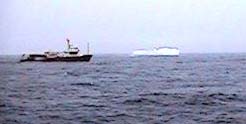
Upon leaving Punta Arenas, Chile, seas were calm and it was sunny and surprisingly mild. At noon on 13 February (Friday the 13th), the weather began to deteriorate as we approached the narrow channel between Isla de los Estados and Tierra del Fuego. As the JOIDES Resolution entered Drake Passage, a full gale with wind gusting to 50 knots was in progress. The results were some spectacularly large waves and sea sickness for several of us.
Drilling does not begin until we toss the beacon over the side. The beacon lands on the seafloor and sends an acoustic signal to the ship navigation room. The signal is used to keep the ship positioned precisely above the drill hole during drilling operations.

We had drilled our first hole to 87.3 meters (95 yards) below seafloor when operations had to be stopped because an iceberg (one of only two on the 24-mile radar screen) closed within 1.6 nautical miles. The drill pipe was pulled above the seafloor and the vessel moved 1000 feet north of the location while the iceberg passed directly over the drilling site. We resumed drilling in a new hole when the iceberg cleared the site.